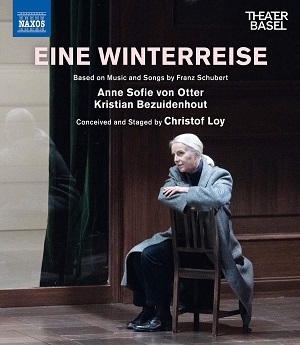
Franz Schubert (1797-1828)
Eine Winterreise, based on Schubert’s music, conceived and staged by Christof Loy
Anne Sofie von Otter (mezzo-soprano)
Kristian Bezuidenhout (fortepiano)
Christof Loy (director)
rec. live, 21 February 2022, Theater Basel, Basel, Switzerland
Naxos NBD0165V Blu-ray [109]
Director Christof Loy and colleagues present a piece of music theatre. Schubert’s short life and an imagined longer one are depicted mainly through selected songs. The music comes from Winterreise, Die schöne Müllerin and Schwanengesang, a few other songs, some solo piano music, and part of Fantasy D934. This, then, is not a staged version of Winterreise – there have been some of those – but, as the title says, A Winter Journey. The famous cycle is a departure point here, but only six of the best-known and most-loved of the twenty-four songs make an appearance.
The soul of the composer is brought to life on stage by a Schubert – called only Er (He) – who survived beyond his 31st year. Mezzo-soprano Anne Sofie von Otter, the only singer here, plays the part, and fortepianist Kristian Bezuidenhout accompanies her. The only other musical sounds are two short contributions of violinist Claudio Rado.
There are other silent players on stage, two men and two women. Schubert’s close friend Franz von Schober was a fellow lodger at times, and a young poet whose work the composer set to music. There is also a Doppelgänger, a more mature and melancholy double of Schubert. The Courtesan is the girl who infected Schubert with the syphilis that may have caused his early death. The other woman, Viola, is related to the thirteen-minute ballad Viola D786, which Schubert set in 1823 to Schober’s poem. The Lied is dramatized because, in Loy’s words, ‘as a mini-drama it forms the centrepiece of our performance’.
Herbert Murauer’s stage setting is a dilapidated 19th-century dance hall. The roof is falling in; one of the entrances is fully glazed to reveal views of the outside world. The interior contains Kristian Bezuidenhout’s fortepiano, at which he sits all the time, and scattered chairs and tables. Those chairs get much more scattered in a lively episode when the cast members move, remove and throw them about.
Christof Loy expertly directs that small cast of actors and dancers. They interact with affection, sometimes aggression, sometimes with emotions in between, as various episodes are enacted by these revenants from Schubert’s past and various imagined futures. The effect is intriguing, even if exact meaning and significance of some passages can be ambiguous. Then again, Schubert’s art is emotionally ambiguous in any case. The main outlines of his life and friendships (which any viewer will need to know something about) form the context. The selection of music evokes the moods of the various scenes. Texts not from songs are read, not sung. There are two passages from Schubert’s famous short prose piece of July 1822 called Mein Traum (My Dream), and one from Wilhelm Müller’s Epilogue to Die schöne Müllerin, which Schubert did not set to music.
If you can, put the song sequences of the familiar cycles out of your head. Otherwise it might be disorienting to hear Die Nebensonnen, the penultimate song in Winterreise, followed at once by Des Baches Wiegenlied, the final song of Die schöne Müllerin. But these are tracks 23 and 24 of 26, so by that time it proved easy to adjust: the musical sequence is determined by dramatic considerations other than those of Wilhelm Müller. The singer and the director, who collaborated on the selection of items, have thought in terms of individual songs rather than cycles.
MusicWeb visitors will care most about the musical side of things. Rest assured this is in very good hands, literally so in the case of Kristian Bezuidenhout. There must be nothing like this in his repertoire. He is required to sit at the keyboard for a hundred minutes, play some solos, but mostly accompany one singer (and occasionally a violinist). He is the only contributor fully involved. On this evidence, he sounds a natural, instinctive Schubertian, alive to the play of mood and colour in each accompaniment. The fortepiano’s tone gives pleasure in itself, and takes us back to Schubert’s time.
The main triumph belongs to Anne Sofie von Otter. She sounds virtually as she did in her prime. Perhaps she is still in her prime, so appealing and unaffected is her singing, the tone and intonation as secure and attractive as ever. Over the long stretch of Viola, she sounds much as she did on her fine 1997 Schubert recital for Deutsche Grammophon, except here she is live, and has much to sing either side of that Lied. If the appeal of this programme for you is mainly the mezzo’s account of her music, you will not be disappointed. For many, she may be the reason to return to the disc.
The Blu-ray film captures the staging well, there is good stereo sound, with voice and fortepiano truthfully reproduced. The booklet has an informative interview in English and German with Christoph Loy, worth reading beforehand, and a detailed track list.
Roy Westbrook
Help us financially by purchasing from



Other contributors
Der Geiger: Claudio Rado
Der Doppelgänger: Nicolas Franciscus
Schober: Kristian Alm
Viola: Giulia Tornarolli
Die Kurtisane: Matilda Gustaffson
Production staff
Set and costume designer: Herbert Murauer
Lighting designer: Roland Edrich
Dramaturgy: Niels Nuijten
Film director: Friedrich Gatz
Production details
Video format HD 16:9. Sound PCM Stereo.
Regions A, B, C. BD25
Subtitles: German, English, French, Japanese, Korean


















